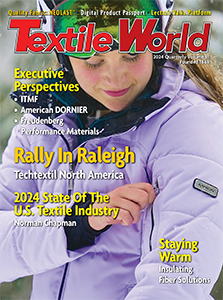Climate change is today’s global issue. Reports of child labor, exploitative working
conditions and the destruction of the environment also are inducing increasing numbers of consumers
to include the conditions under which a product is manufactured in their purchasing decision. The
textile industry in general, and textile finishing in particular, produced fabrics for centuries in
a not very environmentally friendly manner. This situation began to change in the mid 1980s, mainly
in Europe.
First, Öko-Tex Standard 100
On the consumer side, well-known institutes such as Zurich-based Testex started the
initiative of Öko-Text Standard 100, which is applied in many countries around the world. However,
this standard was, and is, only on a humble scale with its impact on the environment. Througout the
1990s, consciousness of the environment increased. For consumers in highly developed,
industrialized countries, textiles should contain no residues of harmful substances that are
hazardous to health.
Then, Öko-Text Standard 1000
A number of prominent textile testing institutions already recognized the trend to
non-harmful fabrics in the 1990s. They jointly defined the standards that a textile product has to
fulfill in order to qualify as safe in every respect, and set out to document the relevant
requirements. Manufacturing plants that have undergone the comprehensive examination and have
achieved the prescribed standard can attach the “Confidence in textiles – Eco-friendly factory
according to Öko-Tex Standard 1000 label to their production site. The former and still valid
Öko-Tex Standard 100 provided the basis. Unfortunately, the Öko-Tex Standard 1000 certificate is
not yet widely known in the marketplace.
To obtain the label, the plant’s compliance with environmentally relevant
legislation and regulations must be verified. This is primarily a matter of analyzing exhaust air
and wastewater values, as well as noise emissions. The dyestuffs and chemicals in use also have to
be reviewed in terms of their compliance with Öko-Tex Standard 1000 and in some cases replaced,
which in turn results in adjustments to formulations and processes, of course.
Widely Accepted
To date, 35 plants have been certified for compliance with Öko-Tex Standard 1000.
With one exception, those plants are in Europe. In view of the growing suspicion with which
European consumers regard Asian goods, textile producers in the Far East are well-advised to
consider comprehensive certification. Especially for the several thousand mills in China whose
textile products have already been tested according to human ecological criteria such as hazardous
residues in fabrics, and certified with the Öko-Tex Standard 100 label, it is worthwhile to make
additional investments in environmentally compatible and social production conditions. If a company
is certified for compliance with Öko-Tex Standard 1000 and its products are already certified for
compliance with Öko-Tex Standard 100, it can under certain conditions obtain the “Öko-Tex Standard
100plus” label for these products.
Next Is ISO 14001
As a follow-up to Öko-Tex Standard 1000, companies are able to obtain ISO 14001
certification relatively easily. Switzerland-based Cilander reported this step also made it clear
that the company had put its mission statement into practice with regard to environmental
protection and thus assures its customers of security, which is far from standard. Its reputation
as a trend-setting partner in the finishing field has been reinforced not least by the Öko-Tex
Standard 1000 label, and Cilander is currently recording interesting growth rates.
Certified companies are mostly connected to a production chain from fibers to
garments. Öko-Tex Standard 1000 has great potential and is in demand. Production plants and trading
chains with well-known, top-ranking brands should be convinced of Öko-Tex Standard 1000.
Important Selling Points
In Europe and other industrialized countries, preserving the environment and
maintaining socially responsible working conditions are important selling points — and are becoming
more so. According to reports from important European textile manufacturers and finishers, the
effort expended to meet the stringent criteria of Öko-Tex Standard 1000 has paid off. Some
companies want to be a showpiece company with regard to the environment, working conditions and the
manufacture of textiles that are recognized as completely safe in terms of health.
December 11, 2007




